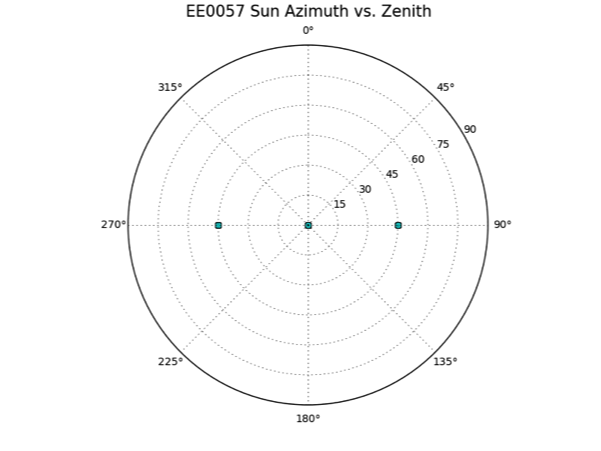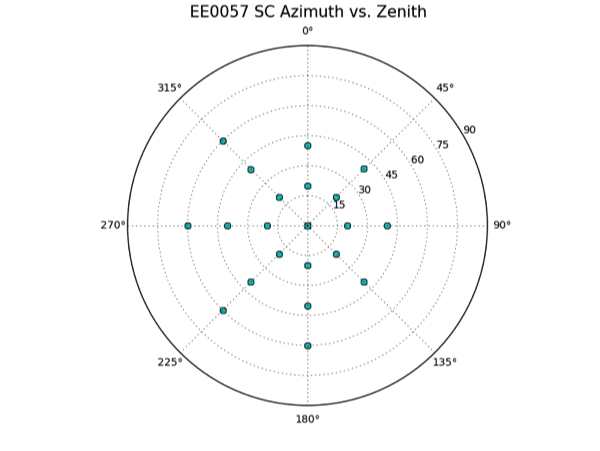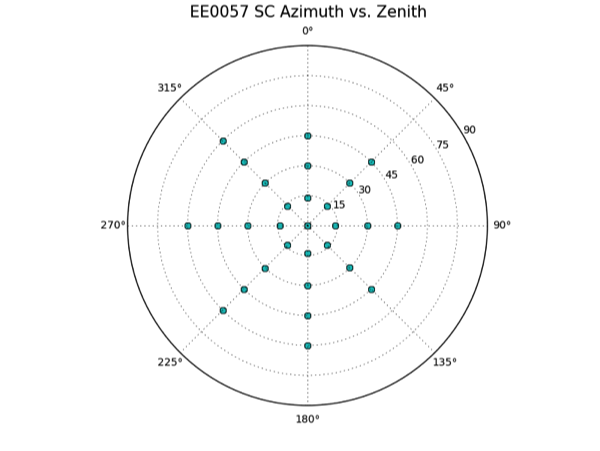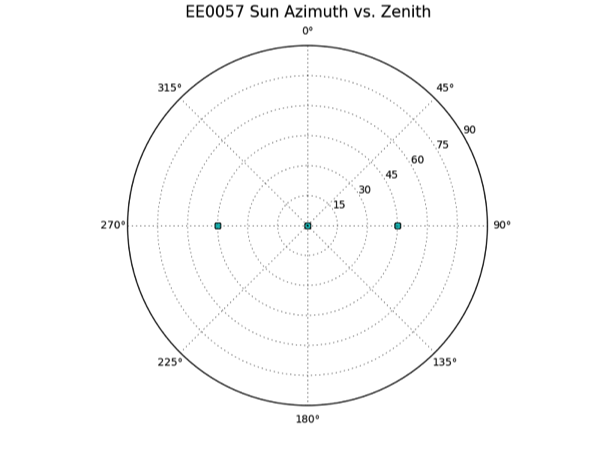|
Size: 3637
Comment:
|
Size: 6302
Comment:
|
| Deletions are marked like this. | Additions are marked like this. |
| Line 13: | Line 13: |
| The 'boulder' was simulated by generating a simple axe-symmetric, flat-topped cone (peak) with a constant 20 degree slope. Multiple peaks and (simplified) craters are randomly placed in an otherwise flat landscape of width approx. 22.5m. | The 'boulder' was simulated by generating a simple axi-symmetric, flat-topped cone (peak) with a constant 20 degree slope. Multiple peaks and (simplified) craters are randomly placed in an otherwise flat landscape of width approx. 22.5m. |
| Line 98: | Line 98: |
| '''Minima''' |
|
| Line 99: | Line 101: |
| '''Within-measure range of minima:''' | ||||Within-measure range of minima|| |
| Line 105: | Line 108: |
| * All minima were below the image resolution (2cm). * Formal uncertainties display a negative trend which appears to still be decreasing after 50 iterations. * The RMSs reached minima within the first 30 iterations and then diverged. No asymptotic behavior is apparent, the RMSs appear to worsen as testing continues to 50 iterations and beyond, although RMSs remain below the image resolution in all cases except TestS's CompMapVec RMS. * Test U consistently achieves the minimum RMS values in the least number of iterations: 5 to 15 iterations sooner than Test T; and 15 to 20 iterations sooner than Test S (excluding Test S CompMapVec RMS which never improved with iteration). * Test S consistently gives the largest RMS but the smallest formal uncertainty. * Compare OBJ RMSs with and without optimal translation and rotation vary across tests by less than 0.2cm, with optimal translation and rotation giving consistently better results in fewer iterations (5 to 10 iterations sooner in every test). '''Performance''' All RMSs were lower than the image resolution (2cm) after the 5 cm tiling. All formal uncertainties were lower than the image resolution after 40 iterations. No tests appeared to 'fail', each of the solutions would be deemed acceptable. Heat plots and transits show that all solutions are very good around the edge of the peak's flat top. SPC struggles to model the sharp edge around the base of the peak. Before iterations are performed (bigmap is tiled at 5cm GSD), a trough has formed around the base of the peak. The trough immediately disappears when iterations begin and the map shows a simple first order behavior in the transition from slope to flat landscape. '''Tilt''' Tilting of the evaluation area is apparent in all tests. The direction of the tilt is consistent across tests. After 40 iterations: * the surface immediately West of the peak is approximately 1cm below truth; * the surface immediately East of the peak approximately 1cm above truth; * the surface immediately North of the peak is approximately equal with truth; * the surface immediately South of the peak is approximately 2cm above truth. The heat plots show that the tilt is broadly West-East with West tilting downwards and East tilting upwards. |
|
| Line 106: | Line 131: |
Although differences in performance were apparent across the spacecraft zenith variations, each test gave an acceptable solution. It would therefore appear that the combination of spacecraft zenith conditions is not a critical consideration in planning the image suite, as long as the basic good practice for obtaining a good SPC image suite is followed. |
Spacecraft Zenith Variations
Aim and Objectives
Purpose of Test 11: To evaluate SPC's ability to represent a simplified 'boulder' which has a constant 20 degree slope.
Objective for Test 11 S, T & U, Spacecraft Zenith Variations
- To investigate the effect of varying the combination of spacecraft zenith (emission angle) contained in the image suite;
- To investigate the effect of the number of images and viewing conditions.
Methodology
The 'boulder' was simulated by generating a simple axi-symmetric, flat-topped cone (peak) with a constant 20 degree slope. Multiple peaks and (simplified) craters are randomly placed in an otherwise flat landscape of width approx. 22.5m.
Truth map: REGION.MAP
Bigmaps
The following TAG1 bigmaps were tiled/iterated and evaluated:
Starting topography defined from: START1.MAP at pixel/line location 49, 49 (= REGION.MAP at p/l 1125, 1125).
Step |
GSD |
Overlap Ratio |
Q Size |
Width |
Center |
START.MAP |
20cm |
- |
49 |
20m |
REGION.MAP p/l 1125, 1125 (center) |
10cm-Tiling |
10cm |
1.3 |
130 |
20m |
START1.MAP, p/l 49, 49 |
5cm-Tiling |
5cm |
1.3 |
250 |
20m |
START1.MAP, p/l 49, 49 |
5cm-Iterations |
5cm |
- |
- |
20m |
START1.MAP, p/l 49, 49 |
Evaluation Map |
1cm |
- |
200 |
4m |
REGION.MAP, p/l 996, 1005 |
Tiling/Iteration Parameters
Auto-Elimination Parameters: |
0, 60, .25, .25, 0, 3 |
Reset albedo/slopes |
NO |
Determine Central Vector |
YES |
Differential Stereo |
YES |
Shadows |
YES |
Tiling seed files: t11-10.seed , t11-05.seed
Iteration seed file : Piteate2StSh-woAYY
Data
- Data was generated by ??.
- Image resolutions: 2cm/pixel.
Viewing Conditions
Name |
Sun |
S/C Az |
S/C Zenith |
Total Number of Images |
Test11S |
45, 0, -45 |
every 45 |
0, 30, 60 |
80 |
Test11T |
45, 0, -45 |
every 45 |
0, 20, 40, 60 |
112 |
Test11U |
45, 0, -45 |
every 45 |
0, 15, 30, 45, 60 |
144 |
Note that a larger image suite was planned and produced than was utilized during test. The images for a number of planned viewing conditions were eliminated due to image quality related to the viewing conditions being unfit for SPC. For further details are contained here:
Test11STU Unsuitable Viewing Conditions.
Test11S Viewing Conditions


Test11T Viewing Conditions


Test11U Viewing Conditions


Results
Results with Overlaps:
Test Over11STU Comparative Results
Results without Overlaps:
Discussion
Minima
From an inspection of the minimum formal uncertainty, CompMapVec RMS and CompareOBJ RMS (both the minimum value and the number of iterations at which the minimum occurs), for tests S, T and U, the following is apparent.
Within-measure range of minima |
|
Formal Uncertainty |
1.511 +/- 0.087 cm |
CompMapVec RMS |
0.875 +/- 0.325 cm |
CompareOBJ RMS |
0.938 +/- 0.097 cm |
CompareOBJ with Optimal Trans & Rot |
0.435 +/- 0.072 cm |
- All minima were below the image resolution (2cm).
- Formal uncertainties display a negative trend which appears to still be decreasing after 50 iterations.
The RMSs reached minima within the first 30 iterations and then diverged. No asymptotic behavior is apparent, the RMSs appear to worsen as testing continues to 50 iterations and beyond, although RMSs remain below the image resolution in all cases except TestS's CompMapVec RMS.
Test U consistently achieves the minimum RMS values in the least number of iterations: 5 to 15 iterations sooner than Test T; and 15 to 20 iterations sooner than Test S (excluding Test S CompMapVec RMS which never improved with iteration).
- Test S consistently gives the largest RMS but the smallest formal uncertainty.
- Compare OBJ RMSs with and without optimal translation and rotation vary across tests by less than 0.2cm, with optimal translation and rotation giving consistently better results in fewer iterations (5 to 10 iterations sooner in every test).
Performance
All RMSs were lower than the image resolution (2cm) after the 5 cm tiling. All formal uncertainties were lower than the image resolution after 40 iterations. No tests appeared to 'fail', each of the solutions would be deemed acceptable.
Heat plots and transits show that all solutions are very good around the edge of the peak's flat top. SPC struggles to model the sharp edge around the base of the peak. Before iterations are performed (bigmap is tiled at 5cm GSD), a trough has formed around the base of the peak. The trough immediately disappears when iterations begin and the map shows a simple first order behavior in the transition from slope to flat landscape.
Tilt
Tilting of the evaluation area is apparent in all tests. The direction of the tilt is consistent across tests. After 40 iterations:
- the surface immediately West of the peak is approximately 1cm below truth;
- the surface immediately East of the peak approximately 1cm above truth;
- the surface immediately North of the peak is approximately equal with truth;
- the surface immediately South of the peak is approximately 2cm above truth.
The heat plots show that the tilt is broadly West-East with West tilting downwards and East tilting upwards.
Conclusion
Although differences in performance were apparent across the spacecraft zenith variations, each test gave an acceptable solution. It would therefore appear that the combination of spacecraft zenith conditions is not a critical consideration in planning the image suite, as long as the basic good practice for obtaining a good SPC image suite is followed.
